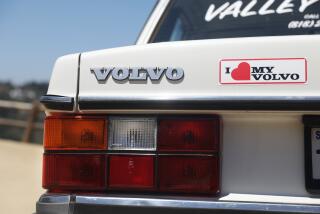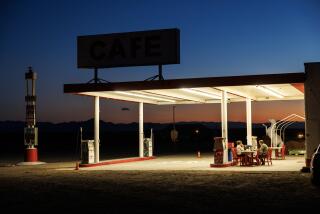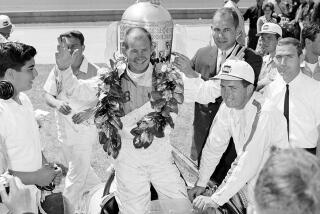On the road ... but out of gas
- Share via
IT’S A SHAME about the Pa Joads and Willy Lomans.
Too bad about Dean Moriarty, and Thelma and Louise. Ditto Humbert Humbert and Clyde Barrow. All dead on the cultural interstate. Road kill now, every last one of them, flattened by the high price of gas.
Something in every American cultural genre of the last half a dozen decades -- books, movies, pop music, high art and low -- has sputtered or sped along on the fuel of cheap gasoline. Four wheels and forward motion; sex and crime on tuck-and-roll upholstery; work and redemption on that long, unspooling promise of pavement. Thanks to Ford, anyone could afford a car. Thanks to Standard Oil, anyone could afford gas. Anyone could become the star of his own road story.
But what would have happened to this six-cylinder cultural patrimony of ours if gas had been three dollars a gallon and ascending? What will become of blacktop therapy -- that restless, aimless cruising, the driving for the sheer pleasure of it? John Steinbeck asked in “The Grapes of Wrath”: “When we can’t buy no more gas -- what then?” Yes, what changes in the fiction and films of this driven nation?
Grounded, hero and antihero alike. Loman, Arthur Miller’s traveling salesman who lives and dies by his wheels -- would he make his rounds on Amtrak? How could Lolita and Humbert Humbert manage their motel-to-motel hegira without a car? Motels themselves began as the spawn of sparkplugs. How would Larry McMurtry’s Cadillac Jack McGriff racket around the country, phoning up his exes from the fast lane -- by carpool? How dangerously disarming would Kerouac’s road renegade Moriarty be if he were the kind of man who stole T-bills instead of T-Birds?
I could take Nancy Drew or leave her, with her saddle-shoe Sherlock Holmes “Eurekas” and her wet-noodle boyfriend -- but oh, that blue roadster sucked me in every time. It was a natural; my first car seat had a toy steering wheel on it.
Katie Mills, the daughter of a traveling saleswoman, has just written “The Road Story and the Rebel.” She calls the phenomenon “automobility” -- autonomy and mobility, the striking recurrence of road stories as vehicles for “Americans’ sense of the self as autonomous and mobile.” It was so, so easy when the cost of gas didn’t figure into even the most realistic fictional calculations.
But how now to craft the great, grand exit, the death-on-radials? The lowbrow Myrtle gets struck down on the road by the aristocratic Daisy, who’s not driving Jay Gatsby’s yellow Rolls-Royce this time but is a passenger on a Greyhound bus? Gee, how would that story turn out?
Would Spielberg be stuck making educational filmstrips today if gas prices were so high that it wouldn’t have occurred to him to make his first feature a car-versus-semi “Duel”? Bonnie and Clyde lose a certain panache, knocking over banks according to a train schedule. “Easy Rider,” “American Graffiti,” even “Beavis and Butt-head Do America” -- would they ever have been greenlighted? The getaway scene at the end of “The Graduate” is touchingly comic precisely because the pair escapes on a bus. So unromantic. So un-American.
Nicholson and Streep have the Oscars, but the car has the juice. It’s the hardest-working performer in showbiz. Think of some favorite movie, a movie set in the last half a century or so. Think how often the plot device turns on some chance encounter made possible by a freewheeling four-wheeled vehicle.
Take the internal combustion engine out of American movies and what have you got? “My Dinner With Andre,” that’s what.
The biggest birthday celebration in the country just now isn’t George W. Bush’s 60th -- it’s the interstate highway system’s 50th, a yearlong tribute to the day half a century ago that an idea became, well, concrete. It was the project of President Eisenhower, who, during World War II, saw the merit of the German autobahn at the same time he was hunting down the rathskeller rat who built it.
Ike’s motivations may have been commerce and national security, but those 47,000 miles of interstate became as big a plot line as war or sex. TV’s pinnacle road-trip show, “Route 66,” the classic post-interstate buddy series, became one long ad for the open road and the open-top Corvette.
And music didn’t just go along for the ride; it slid behind the steering wheel. Adolescence was a perfect closed universe: The cool kids had cars, the cars had radios, and the music coming out of those radios was about kids with cars. When gas was two bits or so a gallon, the Beach Boys could harmonize about Woodies and T-Birds and little deuce coupes, and Chuck Berry could cruise around with no particular place to go. The car got you the girl, and the girl got you ... everything.
Now? As the lady says in the song, “Shut up and drive.”
While you can afford it.
More to Read
Sign up for The Wild
We’ll help you find the best places to hike, bike and run, as well as the perfect silent spots for meditation and yoga.
You may occasionally receive promotional content from the Los Angeles Times.







